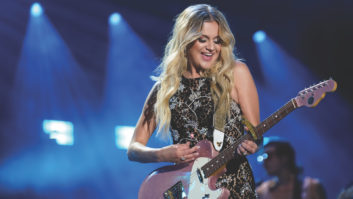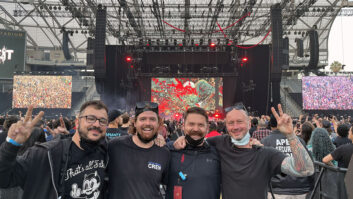Stockholm, Sweden—EDM legend Tim Bergling, better known as Avicii, committed suicide in April 2018, following years of fighting stress and mental illness, leaving behind a legacy of hits and a legion of fans around the world. This past December, 2019 saw his hometown of Stockholm honor one of its own with a massive Avicii Tribute Concert as 58,000 fans filled Friends Arena to both remember the electronic musician, songwriter, producer and remixer, and raise funds for a foundation established by the Bergling family to support mental health research and treatment.
Onhand to evoke their fallen friend were 20 collaborators and peers, including vocalists Rita Ora, Aloe Blacc, Adam Lambert and Dan Tyminski, along with DJ sets from David Guetta, Kygo, Laidback Luke, Dimitri Vegas & Like Mike and Nicky Romero. Production provider The Bright Group supplied a complete audio, video and lighting production package for the event; the production manager was Daniel Hellsten.
Rebuilding the Colosseum with Meyer Sound
The Avicii Tribute Concert entailed numerous challenges for audio production, including visual profile limitations due to live YouTube streaming, noise level restrictions, the sheer volume of the indoor stadium, and a combination of acoustic dampening and reflective surfaces that had plagued previous concerts. Further complicating matters was a program blending a 30-piece orchestra with bass-heavy EDM tracks.
“It’s quite a difficult arena since it’s so huge and there is a lot of dampening,” said audio systems tech Anton Söderberg, who worked on the project, “so it takes a lot of effort from the loudspeaker system to deliver the power and the clarity that we need.” Ultimately, the production went with a Meyer Sound Leo Family system, aided by the presence of system designer Theis Romme of Meyer Sound European Technical Support.
The combination of long throw distances, 270-degree seating and strict noise limits required a distributed approach with multiple delay systems, according to Romme. “The distance from stage to rear topmost seats is about 150 meters and 30 meters high, so we configured the system with delays for both the main front and the out arrays. The coverage turned out to be excellent, with smooth transitions between arrays thanks to the common Leo Family characteristics and great work by Anton.”
The system’s main front arrays were each comprised of 16 Leo-M loudspeakers over two Lyon-W wide coverage loudspeakers, with dual out arrays each configured with 16 Leo-M, four Lyon-M and two Lyon-W loudspeakers. The front fill system deployed a dozen Leopard loudspeakers while the 270-degree far out fills were each 22 Leopard loudspeakers. Full range delay arrays, flown at seven hang points, comprised a total of 104 Lyon-M and 20 Lyon-W loudspeakers and 18 1100-LFC low-frequency control elements.
For uniform bass throughout the venue, Romme laid a foundation with dual end-fire arrays of 9-each 1100-LFC low frequency control elements augmented by 18 1100-LFC elements at center. Another 12 1100-LFC elements were flown in cardioid arrays on each side. System optimization and drive was supplied by 16 Galaxy 816 and three Galaxy 816-AES3 processors linked via an AVB network running the new Milan protocol. All loudspeaker inventory was drawn from Bright Group’s operations in Sweden and Norway.
“The coverage is very smooth with uniform transition between arrays,” observes Söderberg. “The Leo loudspeakers have the throw so we can push the first layer over downstage a bit more, and coverage with the Leopard arrays is just excellent. We also have Leopards as front fills, so the transition from the mains was easy to achieve. Overall, the coverage is above my expectations. The clarity at the top row seats is great.”
As for the AVB network and Milan protocol, there wasn’t much to say, according to Söderberg. “It’s been rock solid,” he says. “Everything pops up on the screen and works like it’s supposed to.”
After the guest DJs finished the opening section of the Avicii Tribute Concert, the YouTube live stream launched for the live performance part of the show. Mixing the band, orchestra and parade of dynamic vocalists was Wayne Sargeant, who came on board as Avicii’s FOH mixer in 2014 for the tour supporting the multi-platinum True album. Sergeant was tasked with corralling 128 inputs for the parade of vocalists and shifting instrumental combinations.
“It’s an incredibly difficult venue, so I thought overall the Meyer Sound system performed remarkably well,” said Sergeant. “Of course, with the orchestra on stage, I was concerned about bass spill, but flying the cardioid sub arrays and putting more cardioid subs out with the delays really pushed the whole show evenly into the back of the room. It was really great having more delays than you can shake a stick at because when you have a noise restriction of around 97 dB, you want a distributed system that takes over from the mains. And it worked. We had buckets of headroom, and the intelligibility was fantastic in a room that’s really tough.”
“I really want to emphasize that we’re doing this for Tim,” production manager Hellsten says. “We’re all in this together. We have 300 people working on the production team and I haven’t heard one complaint. Everybody knows why we are doing this, and everybody is working hard and doing an amazing job.”
Meyer Sound • www.meyersound.com
Tim Berglinger Foundation • www.timberglingfoundation.org






